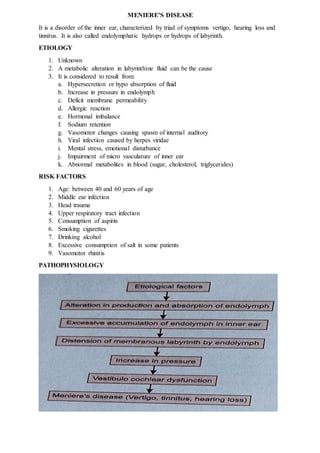MENIERE'S DISEASE.docx
- 1. MENIEREâS DISEASE It is a disorder of the inner ear, characterized by triad of symptoms vertigo, hearing loss and tinnitus. It is also called endolymphatic hydrops or hydrops of labyrinth. ETIOLOGY 1. Unknown 2. A metabolic alteration in labyrinthine fluid can be the cause 3. It is considered to result from: a. Hypersecretion or hypo absorption of fluid b. Increase in pressure in endolymph c. Deficit membrane permeability d. Allergic reaction e. Hormonal imbalance f. Sodium retention g. Vasomotor changes causing spasm of internal auditory h. Viral infection caused by herpes viridae i. Mental stress, emotional disturbance j. Impairment of micro vasculature of inner ear k. Abnormal metabolites in blood (sugar, cholesterol, triglycerides) RISK FACTORS 1. Age: between 40 and 60 years of age 2. Middle ear infection 3. Head trauma 4. Upper respiratory tract infection 5. Consumption of aspirin 6. Smoking cigarettes 7. Drinking alcohol 8. Excessive consumption of salt in some patients 9. Vasomotor rhinitis PATHOPHYSIOLOGY
- 2. CLINICAL MANIFESTATIONS 1. Triad of symptoms of vertigo, tinnitus and hearing loss 2. Other symptoms: a. Nausea, vomiting, headache b. Irritability, depression and withdrawal c. No pain or loss of consciousness occurs patient prefers to lie quietly with his/ her eyes closed. DIAGNOSTIC EVALUATION 1. Audiometric tests are used to check hearing loss 2. MRI of head is helpful to identify pathology 3. Lab tests to rule out metabolic disorders 4. Electronystagmography, electrocochleography and X-ray to rule out other problems. MANAGEMENT 1. To manage the attack a. Atropine may control the attack in 20-30 minutes b. For a mild attack, diphenhydramine, dimenhydrinate, medicine or diazepam may be used. 2. Tranquilizers and vagal blockers may be needed during acute attacks 3. Low sodium diet, typically one to two grams (1000-2000mg) per day is recommended 4. Advice patient to avoid caffeine, alcohol and tobacco 5. In order to lower the pressure within the inner ear, anti-histamines, anticholinergics, steroids are prescribed 6. Diuretics to lower pressure in the endolymphatic system 7. Vasodilators are often used in conjunction with other therapies 8. Some patients who do not respond to treatment may be placed on low doses of methotrexate. 9. Anti-herpes virus drugs (acyclovir) has also been used 10. Antiemetics are used for nausea and vomiting 11. Nutrition: low sodium (2000mg/day) 12. Avoidance of alcohol, caffeine and nicotine SURGICAL MANAGEMENT When medical treatment fails surgical intervention is necessary or needed but there must be residual hearing. 1. Decompression of endolymphatic sac: it is done to decrease the fluid pressure in endolymphatic sac to control vertigo. Here, a shunt is inserted into the sac which allows fluid drainage from inner ear sac when inner ear pressure is elevated. Fluid is reabsorbed in the mastoid cavity. 2. Endolymphatic shunt operation: by introducing a shunt from the inner ear to the subarachinoid space. It helps to drain the fluid and prevent further hearing loss 3. Sacculotomy: a hole is made into the saccule with needle through foo t plate of stapes and extra fluid is dained 4. Labyrinthectomy: when hearing is completely lost and involvement is unilateral, the labyrinthectomy is done
- 3. 5. Intrahepatic gentamycin infection: injection gentamycin is given through tympanic membrane to decrease the attacks of vertigo. COMPLICATIONS 1. Injury/accident due to falls/vertigo 2. Anxiety 3. Progressive imbalance and deafness 4. Intractable tinnitus. NURSING MANAGEMENT 1. Bed rest: with pillow to give support, so that head movement is minimum 2. Nurses need to give assurance especially during acute attacks 3. Administer prescribed medicines 4. Provide a safe environment by keeping bed rails up, maintaining bed in low position and keeping bed side free from clutter 5. Allow the patient to perform tasks at his/her own pace 6. Encourage patient to move slowly 7. Encourage patient to seek assistance a necessary 8. Patient should be given low salt diet and take only required amount of fluids. 9. Avoid exercise where body balance cannot be maintained eg. Swimming, driving, races and mountaineering.


